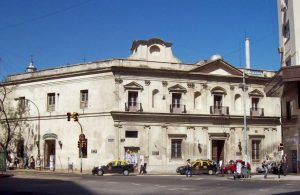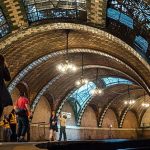 Crime
Crime  Crime
Crime  Technology
Technology 10 Hilariously Over-Engineered Solutions to Simple Problems
 Miscellaneous
Miscellaneous 10 Ironic News Stories Straight out of an Alanis Morissette Song
 Politics
Politics 10 Lesser-Known Far-Right Groups of the 21st Century
 History
History Ten Revealing Facts about Daily Domestic Life in the Old West
 Weird Stuff
Weird Stuff 10 Everyday Products Surprisingly Made by Inmates
 Movies and TV
Movies and TV 10 Actors Dragged out of Retirement for One Key Role
 Creepy
Creepy 10 Lesser-Known Shapeshifter Legends from Around the World
 Animals
Animals 10 Amazing Animal Tales from the Ancient World
 Gaming
Gaming 10 Game Characters Everyone Hated Playing
 Crime
Crime 10 Terrifying Serial Killers from Centuries Ago
 Technology
Technology 10 Hilariously Over-Engineered Solutions to Simple Problems
 Miscellaneous
Miscellaneous 10 Ironic News Stories Straight out of an Alanis Morissette Song
Who's Behind Listverse?

Jamie Frater
Head Editor
Jamie founded Listverse due to an insatiable desire to share fascinating, obscure, and bizarre facts. He has been a guest speaker on numerous national radio and television stations and is a five time published author.
More About Us Politics
Politics 10 Lesser-Known Far-Right Groups of the 21st Century
 History
History Ten Revealing Facts about Daily Domestic Life in the Old West
 Weird Stuff
Weird Stuff 10 Everyday Products Surprisingly Made by Inmates
 Movies and TV
Movies and TV 10 Actors Dragged out of Retirement for One Key Role
 Creepy
Creepy 10 Lesser-Known Shapeshifter Legends from Around the World
 Animals
Animals 10 Amazing Animal Tales from the Ancient World
 Gaming
Gaming 10 Game Characters Everyone Hated Playing
10 Hidden Passages Found Beneath Ancient Monuments
Scientists are constantly making new discoveries about ancient tombs and monuments, usually to the effect of what they were used for. Some of those discoveries, however, involve secret passageways that hide secrets about the ancient world. Here are ten hidden passages that were found beneath ancient monuments and heritage sites you never knew existed!
Related: Top 10 Jaw-Dropping Hidden Spaces In Paris
10 Tunnel in the Great Pyramid of Giza
Most people are aware that the pyramids are home to networks of tunnels that take you between the various chambers. However, that’ s not to say that all the tunnels have been discovered or even that scientists know what they were all used for.
One of the more recent underground tunnel discoveries relating to the ancient world was an underground tunnel found not inside but underneath the Great Pyramid of Giza. The tunnel was discovered in March 2023 and is about 30 feet (9 meters) long. It sits close to the main entrance of the pyramid and was picked up using ultrasonic and radar testing.
As of now, scientists still aren’t sure what the tunnel was used for. However, one theory is that it may have been built to help distribute the weight of the pyramid more evenly. More testing will be needed to see if they can solve the mystery.[1]
9 Teotihuacan
The Great Pyramid of Giza isn’t the only pyramid with a hidden tunnel beneath it. Another pyramid that holds secrets buried deep underground is Teotihuacan’s Pyramid of the Moon.
This pyramid is thought to mirror the great monuments of Teotuhuacan and perhaps represent the underworld. The tunnel is about 33 feet (10 meters) deep and runs from the Plaza de La Luna, the square near the pyramid, to below the pyramid itself.
Although scientists still aren’t sure what the tunnel was used for, they do know that the Pyramid of the Moon was a temple where human sacrifice was performed. So perhaps the tunnel had a similar sinister purpose. It will take more digging and testing to find out for sure.[2]
8 Talatal Ghar
Talatal Ghar is an old military base and palace dating back to the 18th century. It’s located near Assam, India, and was built during the Ahom period in the country.
At first glance, Talatal Ghar is just another army base and 18th-century palace. However, looking a little closer, you’ll quickly unearth the base’s secrets. You see, Talatal Ghar has two secret tunnels that are built around three stories underground.
One tunnel is nearly 2 miles (3.2 kilometers) long, while the other tunnel is almost 10 miles (16 kilometers) in length. The shorter tunnel connects Talatal Ghar to the Dhikow River, while the longer tunnel leads to the nearby Garhgaon Palace.
Unlike some of the other secret tunnels hidden beneath historical sites, scientists actually know the purposes of these passages. The Ahom period was a period of war, and as a result, these tunnels were used as escape routes from the palace during the Ahom wars.[3]
7 Chand Baori
Another Indian heritage site that’s home to secret tunnels is Chand Baori. Chand Baori is a stepwell, or a well or pond with a series of steps leading down to the water, located in the state of Rajasthan.
This type of stepwell was actually pretty common throughout India and was used as a place to gather water, cool down on hot summer days, or hold religious rituals. Many stepwells were built near forts and palaces to make them easy for people to access. The stepwells were popular from around the 7th century until the 18th century.
What’s really interesting about these stepwells, however, is that there was often more to them than meets the eye. Many of them actually provided secret access to an underground tunnel network throughout the Rajasthan state, used to serve as a transportation system in case of an emergency.
Chand Baori is one of these stepwells and grants access to the tunnel network, which extends to various other local monuments and heritage sites, including Amber Fort.
Despite all the intrigue of the stepwell tunnels, there’s some debate as to whether they really do date back to the 8th century. Some historians argue that these may have been built more recently, in the 20th century, in order to draw tourists to the area. It’s up to you to decide which story you believe.[4]
6 The Colosseum
The Colosseum draws thousands of visitors each year, providing a glimpse into ancient Roman culture and some of their more brutal customs and traditions. While tourists have long been free to wander through the Colosseum and get a feel for what it might have been like to watch a game in this ancient monument, they haven’t always been able to go beneath the Colosseum.
The Colosseum had a network of tunnels and passageways hidden underground where gladiators would prepare for their fights. These passengers were invisible to spectators and have remained invisible to tourists for a long time as well.
In 2021, however, several of these hidden underground passageways were restored, making it possible for tourists and scientists alike to learn more about them. So perhaps it’s time to plan a trip to Rome to explore some of the ancient world’s hidden passageways.[5]
5 Manzana de las Luces

Manzana de las Luces is an old Jesuit religious complex that sits in San Telma, Argentina. The complex was built in the late 1500s and was part of a mission to promote Christianity in the New World.
Despite their lofty mission, the Jesuits weren’t welcome in Argentina, with indigenous groups threatening them with armed conflict. To protect themselves, the Jesuits at the Mazana de las Luces mission began to create a network of tunnels beneath the church that extended out to other churches around the city. The idea was to give them an escape plan in the event that the natives launched a serious attack.
Interestingly enough, these tunnels were never properly documented, making it challenging for scientists to uncover the true extent or purpose of the tunnels. The tunnels were originally found in the 1900s during a construction project, and other tunnels suspected to have been part of the network have been found over the years during other construction projects.
Sadly, many of these tunnels have since been lost to time. However, tourists can still check out a short section directly under the Manzana de las Luces mission.[6]
4 Chauvin de Huantar
Chavin de Huantar is an ancient archaeological site located in the highlands of Peru. It is believed to have been built by the Chavin culture, which flourished between 900 BC and 200 BC. The site is known for its impressive architectural features, including a complex network of underground tunnels that were used for ceremonial purposes.
The hidden tunnels of Chavin de Huantar are an important part of the site’s history and significance. The tunnels were built using sophisticated engineering techniques and were designed to channel water and connect different parts of the site. They also played a role in the religious practices of the Chavin culture, as they were used for ceremonies and possibly as a way to communicate with the gods.
The passageways were discovered in the 1940s by Peruvian archaeologist Julio C. Tello. Since then, they have been extensively studied and explored by archaeologists and other experts. Today, Chavin de Huantar is considered one of Peru’s most important archaeological sites and a popular tourist destination. Visitors can explore the underground tunnels and other architectural features of the site, including the Temple of Chavin, a massive stone structure decorated with intricate carvings and sculptures.[7]
3 Red Fort
The Red Fort is a Mughal Empire-era fort that sits in the Old City in Delhi, India. This fort is a UNESCO World Heritage site and attracts many visitors each year looking to learn a bit more about the country’s history.
Recently, however, scientists discovered that there was a secret hiding beneath the Red Fort. The tunnel, which connects to the Delhi Legislative Assembly, was discovered in 2021. It seems to have once been a tunnel used by the British to move freedom fighters around the city. Still, the exact history and purpose are up for much debate, and historians haven’t been able to find detailed records about it.
What’s more, much of the tunnel has been destroyed in recent years. Thanks to the construction of the Delhi Metro and sewer system, the full tunnel no longer remains intact. Despite this, Delhi officials have hopes of restoring at least a small section of the tunnel and making it available to the public to check out.[8]
2 Taposiris Magna
The Taposiris Magna is an ancient Egyptian city that sits outside modern-day Alexandria. This ancient city is home to ruins, temples, and unique historical sites. However, it’s also home to a recently discovered network of tunnels that sits below one of the temples in the village.
The tunnel network is more than 13,770 feet (4,200 meters) long and is about 6.5 feet (2 meters) tall. The tunnel is hidden about 65 feet (20 meters) underground and seems to be an exact replica of the Eupalinos Tunnel in Samos, Greece, which was used to move water.
This is most likely due to the fact that the tunnel dates back to the Ptolemaic period when Egypt was ruled by Greece. Scientists are still excavating at the tunnel to learn more about it, but as of now, it’s also thought to have been built to move water around the ancient city.[9]
1 Royal Palace of Naples
The Royal Palace is a palace in Naples, Italy, that was owned by Ferdinand II of Bourbon during the 18th century. However, beyond the riches and treasures hidden within the castle’s walls are far more secrets beneath the Palazzo itself.
You see, beneath the palace lies a network of tunnels built by King Ferdinand II in the 1800s due to fear of a revolutionary uprising. The tunnels are huge, designed to fit military troops and horses and lead them from the barracks to the Royal Palace.
Interestingly enough, the tunnels are home to much more modern artifacts than you might think based on when they were built. During World War II, they were used as bomb shelters as well as a place to smuggle contraband vehicles before they were closed off in the 1950s. As a result, many of the artifacts within the tunnels date back to this more modern period.
The tunnels were rediscovered by accident when scientists conducted seismic testing on the area. Today, the tunnels can be visited by tourists, often as part of a tour of the Royal Palace of Naples.[10]








